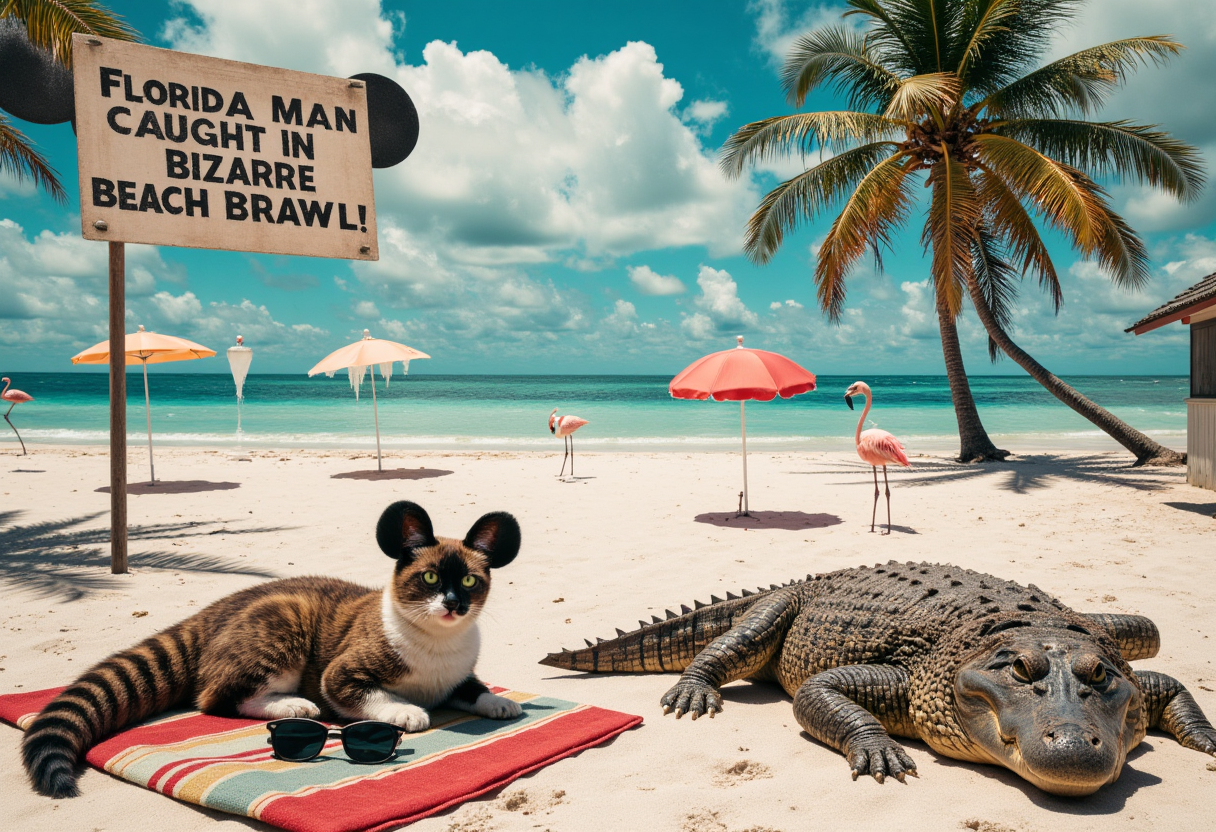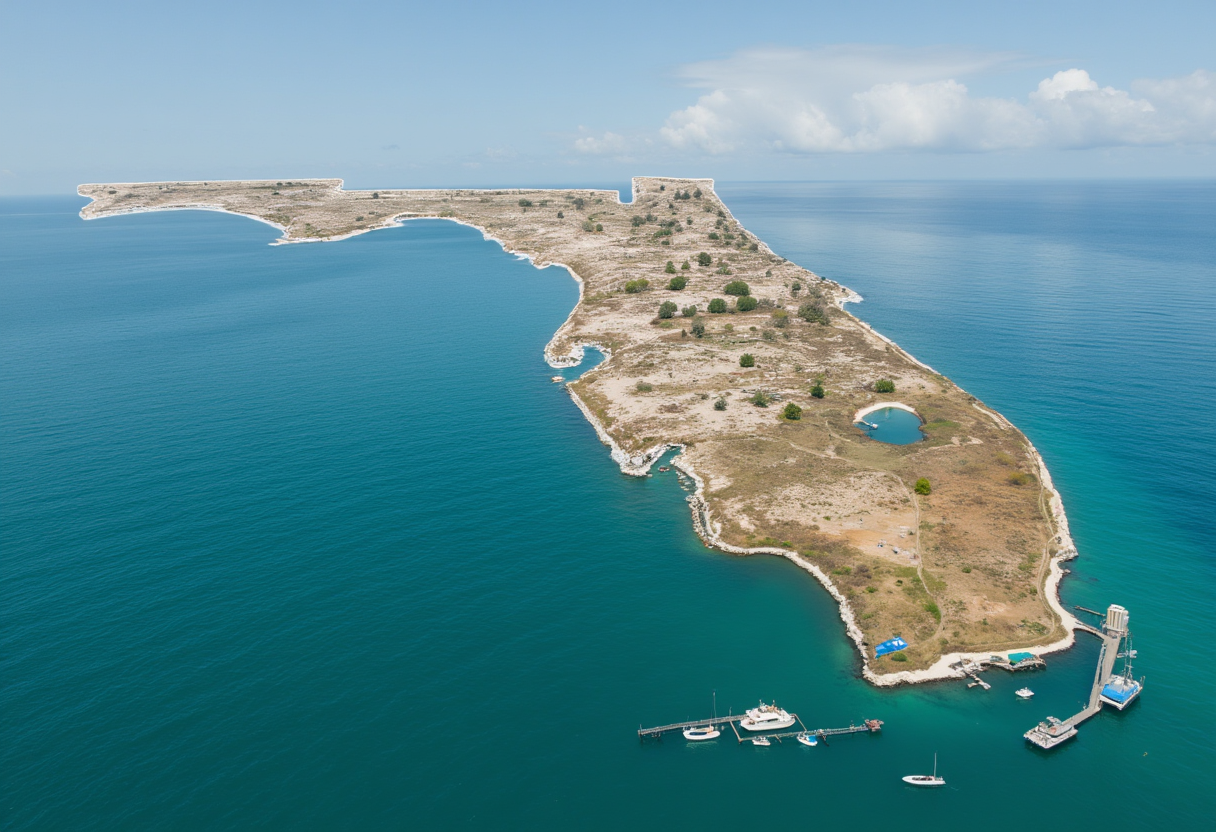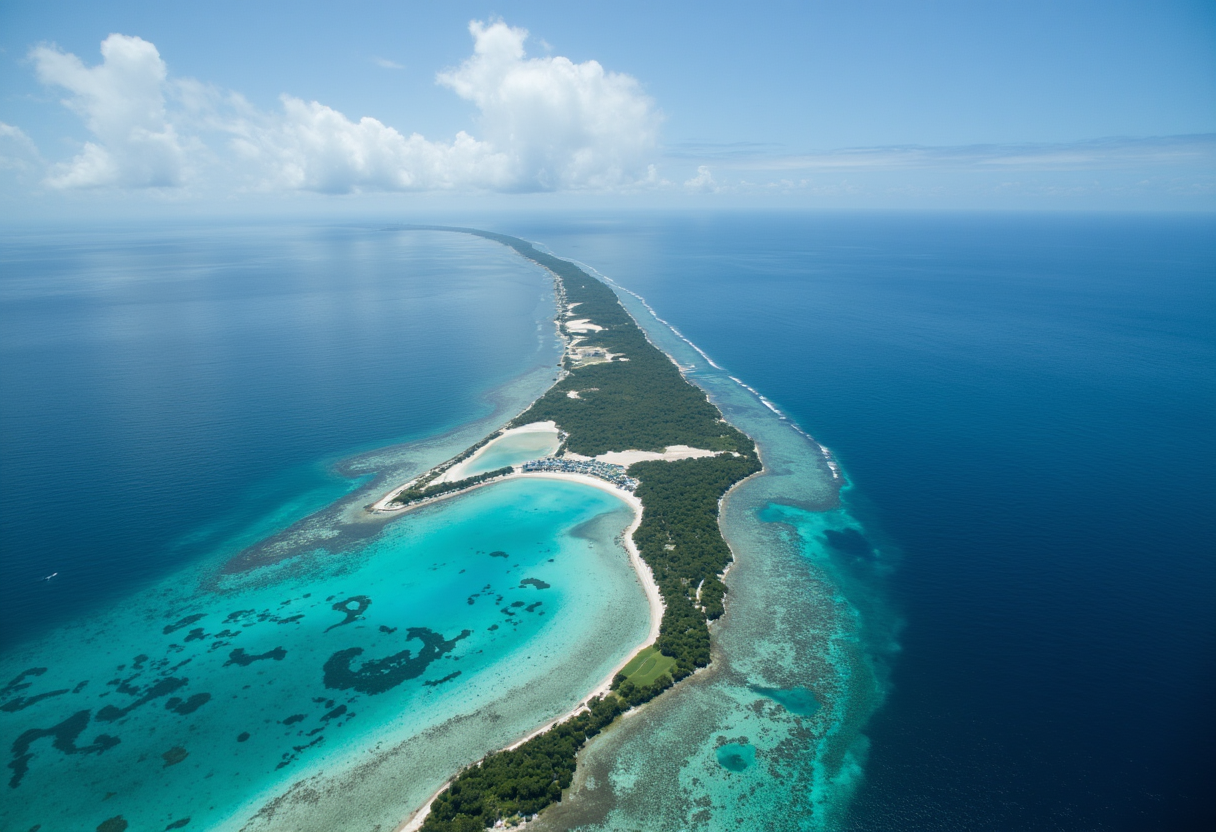25 Florida Facts You Won’t Believe Are Real (But Totally Are)
collage that embodies the eccentric spirit of Florida, blending the mundane with the fantastical. Depict a sprawling, surreal landscape that brings together a cast of characters in a single, mesmerizing scene. In the foreground, a six-toed cat with a mischievous glint in its eye lounges on a weathered beach towel, its tail curled around a faded pair of sunglasses. Nearby, a massive alligator and a crocodile sit side by side, their scaly bodies seemingly frozen in a moment of companionable stillness
Think you’ve got Florida all figured out? Beaches, retirees, Disney World, maybe the occasional Florida Man headline — but that barely scratches the surface of these Florida Facts.
This is the Florida where six-toed cats roam Hemingway’s Key West house, where both alligators and crocodiles are native, and where history and wildness collide in unexpected ways.
Across the Florida state you’ll find weird laws, huge coastlines, unique wildlife, and historic cities — a place of sun, surf, strange festivals, and incredible biodiversity. In the next few minutes you’ll get nature and wildlife highlights, odd cultural quirks, and must-see parks and cities to add to your list.
So grab a key lime pie, duck under the nearest palm, and dive into these surprising, true, and delightfully odd facts about the Sunshine State. Read on for surprising Florida Facts — save or share your favorite.
1. Florida Is Flat—Like, Really Flat
Florida is remarkably flat: the state's highest natural point, Britton Hill, tops out at just 345 feet above sea level (USGS). That low relief means gentle bike rides and very few mountain views — and it helps explain why water can spread quickly during heavy rains and storm surge.
2. Gators AND Crocs Call It Home
Florida is the only place in the world where the American alligator and the American crocodile share habitat ranges. Alligators are widespread across freshwater marshes and ponds statewide, while American crocodiles are primarily found in southern coastal and Everglades areas — an unusual overlap that makes the Everglades a unique reptile hotspot (Florida Fish & Wildlife Conservation Commission).
3. The Florida Keys Include Over 1,700 Islands
Need island vibes? The Florida Keys chain includes more than 1,700 islands and islets stretching from Key Largo down to Key West, offering everything from lively beach towns to tiny, secluded keys — many fringed by salt water and coral communities.
Florida's got over 1,700 islands stretching from Key Largo to Key West. Some are big enough for bustling bars and Hemingway legends, while others could barely fit your inflatable flamingo pool float.
4. Alligators Are Practically Residents
Florida is estimated to be home to roughly 1.3 million alligators (FWC estimates vary by year), more than any other U.S. state. That means many ponds and wetlands are active wildlife habitat — not public swimming pools — so keep a respectful distance and follow local guidance.
5. St. Augustine Is Older Than Most Countries
St. Augustine, founded in 1565 by Spanish settlers, is the oldest continuously inhabited European-established city in the United States. Its streets, forts, and museums offer direct ties to early European exploration of the Atlantic coast and the broader history of the United States.
6. Hemingway’s Cats Have Extra Toes — and LEGAL RIGHTS
Visit Ernest Hemingway’s former home in Key West and you’ll meet descendants of his polydactyl cat, Snowball — cats with extra toes. The colony is well-known and protected as part of the site’s heritage, reflecting Key West’s quirky blend of literary history and local animal lore.
7. Florida Is the Lightning Capital of the U.S.
Central Florida, especially around Tampa (nicknamed “Lightning Alley”), records some of the highest lightning strike densities in the United States — lightning maps from NOAA and NWS consistently show Central and South Florida as hot spots. It’s a reminder that afternoon storms are part of life here, so keep an eye on weather apps when you head to the beach or the park.
8. “Florida Man” Is Basically Its Own Genre
You’ve seen the headlines:
“Florida Man Tries to Rob Store With Stapler”
“Florida Man Arrested for Slapping Girlfriend with Cheeseburger”
Those viral headlines reflect a mix of open arrest records, prolific local reporting, and quirky human behavior — not a literal state-wide plan. Still, the “Florida Man” meme captures the state’s knack for producing weird, newsworthy moments that travel around the world.
9. It Has the Longest Coastline in the U.S. (Outside Alaska)
Measured in certain ways, Florida’s coastline stretches roughly 1,350 miles — more shoreline than many people expect and longer than California’s measured coastline. Whether you prefer Atlantic Ocean surf, Gulf beaches, or quieter barrier islands, the state offers miles of beaches and shell-hunting opportunities for visitors and residents alike.
10. Florida’s Coral Reef Is the Only One in the Continental U.S.
Florida Is Flat—Like, Really Flat: "An exaggerated aerial view of Florida, depicted as an impossibly flat pancake, with a skyscraper looming much taller than any natural elevation."
The Florida Reef, running along the Florida Keys, is the only living coral barrier reef system in the continental United States and is ranked among the largest in the world. It’s home to sea turtles, tropical fish, and important coral communities; conservation groups and NOAA work to protect it from threats like warming water and disease.
11. The Fountain of Youth Might Be Here (Emphasis on “Might”)
Ponce de León arrived in what is now Florida in the early 1500s searching for the legendary Fountain of Youth (often referenced as pascua florida in Spanish-era accounts). While the fountain remains myth, visitors can sip from the spring at the Fountain of Youth Archaeological Park in St. Augustine and stroll a city whose roots go back centuries.
12. Florida Means “The Land of Flowers”
The name “Florida” comes from the Spanish La Florida, a name Juan Ponce de León gave during the Easter season’s “feast of flowers” (pascua florida). The state flower and the abundance of orange blossom-scented groves are part of that floral legacy.
13. Key West Is Closer to Cuba Than to Miami
It’s true: Key West sits about 90 miles from Havana and roughly 160 miles from Miami by straight-line distance. That closeness helped shape the Keys’ culture, cuisine, and maritime history — and it’s one reason Key West and the Florida Keys feel like a place apart from the mainland.
14. There's a Law Prohibiting Rolling a Barrel Down the Street
Yes — Pensacola has an old ordinance that makes rolling a barrel down certain streets illegal. Many of these quirky local laws date back decades and were created for safety or nuisance reasons; if you’re curious, check the municipal code before you stage any barrel-related stunts.
15. Florida Has a Town Named “Christmas” Where It’s Always December
There’s a small community in Florida called Christmas, and locals embrace the holiday spirit year-round — from seasonal postmarks to festive décor. It’s one of those charmingly odd place names that makes Florida feel like a collection of stories.
"An inviting shot of a key lime pie and a refreshing drink under a palm tree, with a hint of something bizarre or unexpected happening in the background."
16. You Can Legally Own a Kangaroo in Florida
Some exotic pets — including kangaroos — are allowed in parts of Florida with the right permits and county rules; regulations vary widely, and animals like sloths or large reptiles often require special licensing (and expert care). Before bringing an unusual animal home, always check state and local laws and consider the animal’s welfare.
17. It Hosts the Mullet Toss World Championship
Each spring, the Floribama region stages the Annual Interstate Mullet Toss, a tongue-in-cheek competition where contestants fling a (frozen) mullet across the state line. It’s a kitschy, long-running tradition that draws visitors and highlights Gulf Coast fishing culture.
18. It's Home to the U.S.'s Only Live Mermaid Show
At Weeki Wachee Springs State Park, performers put on underwater “mermaid” shows in a natural spring — a uniquely Florida attraction that’s entertained generations and showcases the state’s spring-fed waterways and freshwater life, including manatees in nearby habitats.
19. There Are Sunken Submarines for Divers to Explore
Off the Florida coast you’ll find intentionally sunk vessels turned reefs, including large former military ships like the USS Oriskany — now part of one of the world’s biggest artificial reef projects. These sites draw divers from across the United States for wreck diving, snorkeling, and spotting sea turtles, tropical fish, and other salt water life.
20. Florida Hosts a Pirate Festival Bigger Than Some Towns
The Gasparilla Pirate Festival in Tampa routinely draws massive crowds — organizers report attendance in the hundreds of thousands — turning the city into a daylong parade of faux buccaneers, beads, and community events. It’s Tampa’s distinctive blend of pageantry and party.
21. The World's Largest Pink Flamingo Lives in Florida
The Florida Keys Include Over 1,700 Islands:
Meet “Phoenicopterus Rex,” a 21-foot-tall pink flamingo statue installed at the Tampa airport. It’s a quirky roadside icon that captures the playful, larger-than-life spirit many visitors associate with the state.
22. Florida Produces the Most Oranges in the U.S.
Florida has long been the nation’s leading citrus producer; while exact shares change year to year with weather and disease pressures, orange groves and the scent of orange blossom remain core to the state’s agricultural identity and economy.
23. It Has Its Own Skunk Ape
The Skunk Ape is Florida’s version of Bigfoot — an alleged, foul-smelling, large-hominid sighted in the swamps by visitors and locals. Reports are part folklore, part tourist lore, and part cultural curiosity that adds to Florida’s collection of odd stories.
24. Cape Canaveral Is Rocket Central
The Kennedy Space Center and Cape Canaveral are central to U.S. space launches; many residents and visitors watch rocket launches from nearby beaches and parks, making for unforgettable, easily accessible viewing experiences.
25. Florida Has the Most Diverse Ecosystem in the U.S.
From mangroves and coral reefs to pine flatwoods and freshwater springs, Florida’s ecosystems are among the most diverse in the United States — home to species like the Florida panther, manatees, and countless bird species. If you want a quick to-do list: visit Everglades National Park, the Florida Keys, and one of the state’s many springs to experience that variety firsthand.
🎉 Final Thoughts (And a Little Love from the Sunshine State)
So there you have it — 25 Florida facts that prove the Sunshine State is part paradise, part prehistoric zoo, and completely unforgettable. If you enjoyed these, share the article, subscribe for more oddities, or plan a visit to see these places in person.
Thanks for reading all the way to the end — this post was written with sandy toes, a cold drink nearby, and the full moral support of our dedicated staff of one.
🌴 With curiosity and chaos,
*The Weird Florida Blog Team (literally just me—hi!)*
Earl Lee
"Thanks for reading. Until next time, keep exploring Florida's peculiar charm!"
Florida Unwritten Staff





